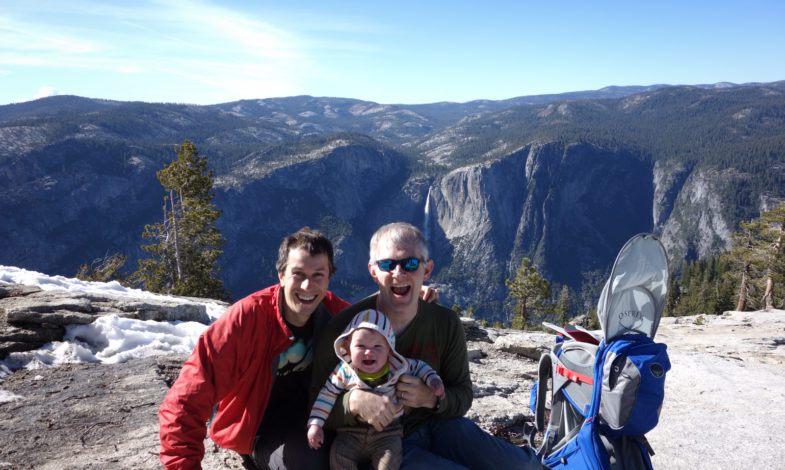
Hiking Yosemite with our new little one
I didn't know much about carriers when I became a father. I knew my sister had used some kind of wrap with her firstborn and that it was somewhat complicated to tie. I also knew about a sling kind of carrier from some of my husband's siblings. Their popularity seemed to be on the upswing, with lots of people talking about the BabyBjorn carrier or the Moby wrap.
I’m the kind of person who likes to research purchases, so I read a bunch of reviews and ruled out the BabyBjorn because it didn't have a waist belt and a number of people complained about back pain. Instead, I settled on a soft-structured carrier called the Beco Gemini, not as well known but very well liked from what I could tell. I also ran across a used Moby wrap and grabbed that too. However, I had to wait a little longer to try these out than I expected.
Our son was born eight weeks early, and at 3 lbs. 13 oz, wouldn't meet the minimum threshold for any of these carriers for several months. Certainly there were ways to wear the Moby with a tiny baby, but I doubted my competence and it wasn't worth any risk. Babywearing was on hold for many months.
Once we started wearing, I only wore the wrap a few times. Twice around the house to test it out, and once on a short hike. I found it to be unbearably hot, though, and both baby and I were sweating profusely. This was in January in California, so I could only imagine what summer would bring. The wrap just wasn't for us.
The Beco was wonderful; it was very comfortable. I could wear the baby around the house with my hands free and get things done. It was everything I hoped it would be ... until he spit up on it the first time.
Yes, it's washable, but it's a thick cotton material so it didn't clean easily and would take a long time to dry. Even with washing, a lot of the fabric was black and it began to accumulate stains and fading, especially where he would chew/suck on it at the top. The temperature control was pretty good around the house, but it became apparent that it wasn't great for hiking even in spring, and would be worse when summer came. Additionally, I had to wear a fanny pack over the waist belt if I wanted to carry diapers, milk, extra clothes and water.
Carrier popularity seemed to be on the upswing from what I saw online, but in the distant suburb of San Francisco where we lived, I didn't see a lot of other people babywearing. And men babywearing was rare. However, it didn't make me uncomfortable to wear our son though because I'm pretty used to being the different one. But when I did see another man with a carrier, I felt a bit of solidarity and would always wave. Kind of like the Corvette wave, but for babywearing guys.
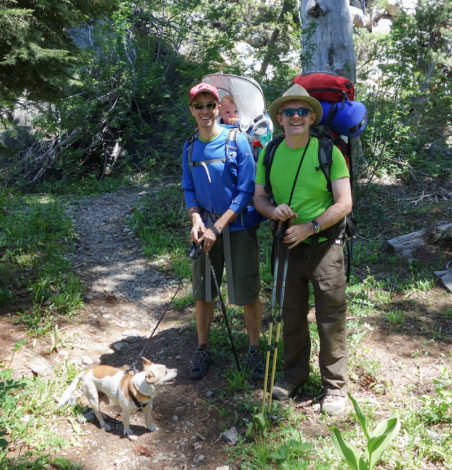
Family weekend backpack trip.
I started looking for something else. I knew from a family trip a few years ago that Kelty made a backpack carrier that worked for older kids. I'd carried a nephew down Lembert Dome in Yosemite (he was 3 or 4 then) and it was pretty comfortable. I went to REI to see what I could try out and found that Osprey also had a carrier. I loved the Osprey backpack that I'd bought about four years before - it was incredibly durable and very well designed. Normally you weigh a backpack with sandbags to test it, but this didn't work well with a carrier. Since this was a big purchase for me, I went so far as to acquire a child-sized doll from a thrift store, cut it open, and fill it with sand until it was twice the weight of my son. Thus tested, the Osprey was comfortable, so it passed. Besides being comfortable, I had two other considerations: pack volume (how much stuff I could cram into it) and sun protection. I was looking at the Osprey Poco Premium and it had a nice built-in sunshade. Also, it had more space than any other carrier I could find - at REI or online - so it seemed like a perfect match. With the help of a 20% off coupon, I splurged on what I hoped would be useful for many years to come.
And it was! Our son is 3 years and 9 months old now and we've used it for just a bit more than three years and on so many hiking trips we've lost count. He fell asleep in it so easily - I was amazed. On day hikes, we might swap it between us and adjusting the torso length was pretty easy. We've used it for a few backpacking trips too, straining it's weight-bearing and capacity to the limit. Knowing what I know now, I would have tried some different things, but it did the job for us and did it well. I wanted to get back to backpacking, and I wanted to share a real wilderness experience with my son as soon as possible, and the frame carrier let us do that, so I was very happy with it.
The Osprey Poco is not without its flaws though. If I went beyond carrying a total weight of 35 pounds or so, I'd start to find the waistbelt uncomfortable. At 45 pounds or more (max load is 48 lbs), I'll get bruises on my hips after a couple miles no matter how I adjust it. That level of weight is unavoidable on a backpacking trip, which we did a few of.
The other drawback I found with frame packs are that they are big. Our frame carrier takes up a lot of space in the car and I don't feel comfortable sending it as baggage on the airplane. I'm afraid one of the tubes will get bent and then it'll be ruined. (
ED NOTE: Check out Deuter as well if you are looking for a frame carrier. They have been a Hike it Baby sponsoring partner for over two years and have a frame pack we love. What we like about the Deuter is that it’s easily adjustable for persons who are different sizes and the waist band is amazing. They are also rated as the safest frame carrier on the market.)
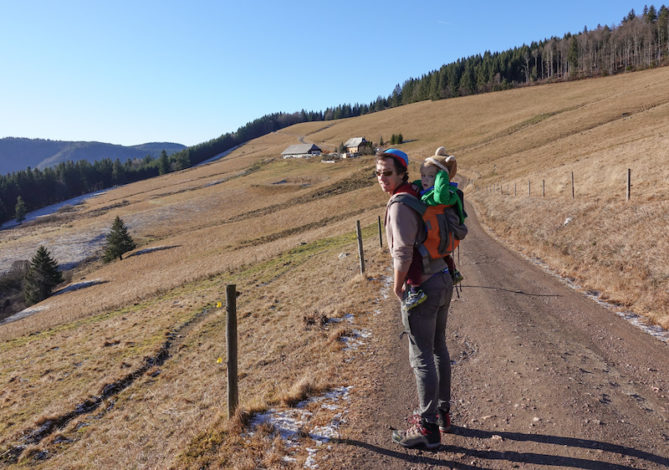
My husband and son hiking in Europe in 2016.
In late 2014, I joined Hike it Baby. I was already hosting hikes for a moms' group I was part of (yes, the only guy), so it was a natural fit. In HiB, I started hearing about the Onya baby carrier. The Onya Outback seemed to be of a similar design to the Beco and just as versatile, but addressing some of the flaws that the Beco had. The fabric was nylon, so it would wash easily and dry quickly. Body heat could even dry it. It had built-in pockets - not enough for everything, but enough for some occasions. Plus, it was far more compact than the Beco, as it had a lot less padding. This was important because I was looking at an international trip in the summer of 2015 and needed a way to carry my son during hikes and any tourist outings where a stroller wouldn't work. Completely unimportant, but fun, the burnt orange of the Outback was a near-perfect match for my Honda Element.
The Onya Outback turned out to be a great match for travel. Although I found the Beco slightly more comfortable, the Onya was definitely superior in terms of maintenance, packability and heat management. So the Beco went into storage after a little more than a year of use and I haven't gotten it out since. That's where things stabilized - we used the Osprey Poco Premium for hiking and backpacking, and we used the Onya Outback for travel and the occasional around-town usage where a stroller or backpack carrier wasn't feasible, like a museum. Once on a trip that involved a lot of hiking, I rented a backpack carrier because we were going to be hiking in the desert in summer and I didn't want to get too hot.
Now, though, my little one isn't so little. When he weighed less, the weight of the Osprey didn't matter so much. Now, with just the pack and my kid, it's 40 lbs. Add the essentials like water, change of clothes, wipes and snacks and I'm carrying 45 lbs. Last August, I geared up to do a solo all-day hike from Tuolumne Meadows with him, and between the extra gear needed and the altitude (8,600 feet), I just couldn't do it. We had to turn around after a mile and do something else. That was the beginning of the end of the Poco for me.
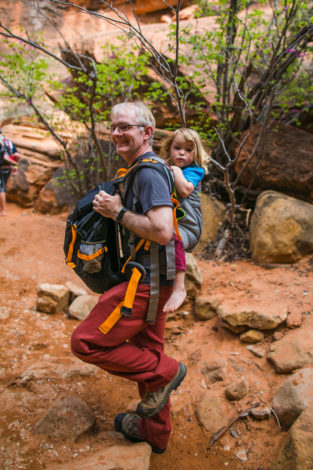
This spring, I was given the opportunity to try out the Onya Baby Pure. While this looks similar to the Outback, there are several substantial differences. The most obvious is the replacement of the pocket and hood with the large zippered ventilation flap. Anything that helps reduce heat when hiking hard is welcomed, so I was all for this. My son never liked the hood and the pocket had turned out to be too small for me to use for much, so neither of these were a big loss. More subtle, the padding on the front was thinner. This meant that the carrier rolled up smaller. I could easily attach it to the outside of a backpack and have it not be in the way. And when traveling, it took up less room in the suitcase. Finally, the placement of the hip belt buckle had changed from the odd, sewn-in side piece to a more conventional location. It was a lot easier to tighten, and I felt I had some options if it broke on a hike. The only downside I could see was the lack of color choices.
We were headed to Utah for a week of hiking around Zion, so it was trial by fire with no backup. On our hikes, I started out with it rolled up and strapped to the side of my daypack. It rolls up pretty small, so it's not in the way. Then when he tires out, or there's a section I don't want him to walk through (thorns, poison ivy, narrow path on a cliff) or we need to go faster, I unstrap it and put it on and we're good to go.
I mentioned I had a daypack, so you might wonder what I do with two packs. I put my son on my back and the pack on my front, or vice versa. I do heat up more, especially if my son is in front, but it does feel comfortable and well balanced. That turns out to be the usual case; my son says he likes to go in front so he can talk to me. I did sort through my daypacks to choose one that worked well in the front. I had to be sure the straps had a wide enough gap in the middle for my neck AND that nothing extended above the straps into my chin AND that the two hip belts could both be worn comfortably. It turned out I had exactly one daypack that met those criteria. We did two hikes carrying him on my back and it worked fine.
I can't really think of a situation where I'd use the Osprey Poco now, given the hikes I do. There might be times when I'd want to carry things with only one pack, but the weight of him plus the Osprey plus stuff is too much and that's only going to get worse. Maybe if it were so hot that I really couldn't stand to have him next to me. We've got a backpacking trip coming up later in the summer and we've always used the Osprey before, but I think this time he'll walk and we'll take the Pure for backup.
What kind of carrier are you using for your hikes? Share comments below and let us know what’s worked best when on the trail with a little one.
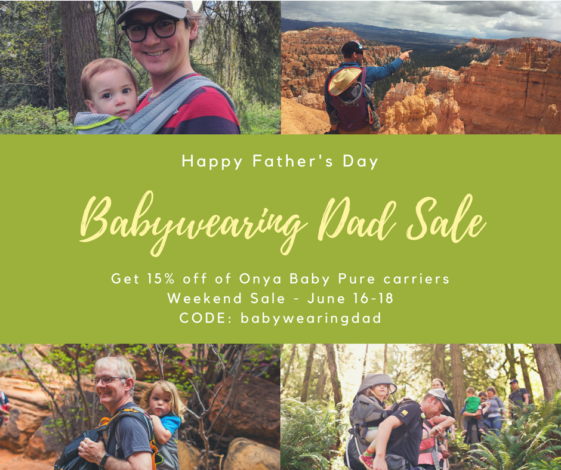



 This spring, I was given the opportunity to try out the Onya Baby Pure. While this looks similar to the Outback, there are several substantial differences. The most obvious is the replacement of the pocket and hood with the large zippered ventilation flap. Anything that helps reduce heat when hiking hard is welcomed, so I was all for this. My son never liked the hood and the pocket had turned out to be too small for me to use for much, so neither of these were a big loss. More subtle, the padding on the front was thinner. This meant that the carrier rolled up smaller. I could easily attach it to the outside of a backpack and have it not be in the way. And when traveling, it took up less room in the suitcase. Finally, the placement of the hip belt buckle had changed from the odd, sewn-in side piece to a more conventional location. It was a lot easier to tighten, and I felt I had some options if it broke on a hike. The only downside I could see was the lack of color choices.
We were headed to Utah for a week of hiking around Zion, so it was trial by fire with no backup. On our hikes, I started out with it rolled up and strapped to the side of my daypack. It rolls up pretty small, so it's not in the way. Then when he tires out, or there's a section I don't want him to walk through (thorns, poison ivy, narrow path on a cliff) or we need to go faster, I unstrap it and put it on and we're good to go.
I mentioned I had a daypack, so you might wonder what I do with two packs. I put my son on my back and the pack on my front, or vice versa. I do heat up more, especially if my son is in front, but it does feel comfortable and well balanced. That turns out to be the usual case; my son says he likes to go in front so he can talk to me. I did sort through my daypacks to choose one that worked well in the front. I had to be sure the straps had a wide enough gap in the middle for my neck AND that nothing extended above the straps into my chin AND that the two hip belts could both be worn comfortably. It turned out I had exactly one daypack that met those criteria. We did two hikes carrying him on my back and it worked fine.
I can't really think of a situation where I'd use the Osprey Poco now, given the hikes I do. There might be times when I'd want to carry things with only one pack, but the weight of him plus the Osprey plus stuff is too much and that's only going to get worse. Maybe if it were so hot that I really couldn't stand to have him next to me. We've got a backpacking trip coming up later in the summer and we've always used the Osprey before, but I think this time he'll walk and we'll take the Pure for backup.
What kind of carrier are you using for your hikes? Share comments below and let us know what’s worked best when on the trail with a little one.
This spring, I was given the opportunity to try out the Onya Baby Pure. While this looks similar to the Outback, there are several substantial differences. The most obvious is the replacement of the pocket and hood with the large zippered ventilation flap. Anything that helps reduce heat when hiking hard is welcomed, so I was all for this. My son never liked the hood and the pocket had turned out to be too small for me to use for much, so neither of these were a big loss. More subtle, the padding on the front was thinner. This meant that the carrier rolled up smaller. I could easily attach it to the outside of a backpack and have it not be in the way. And when traveling, it took up less room in the suitcase. Finally, the placement of the hip belt buckle had changed from the odd, sewn-in side piece to a more conventional location. It was a lot easier to tighten, and I felt I had some options if it broke on a hike. The only downside I could see was the lack of color choices.
We were headed to Utah for a week of hiking around Zion, so it was trial by fire with no backup. On our hikes, I started out with it rolled up and strapped to the side of my daypack. It rolls up pretty small, so it's not in the way. Then when he tires out, or there's a section I don't want him to walk through (thorns, poison ivy, narrow path on a cliff) or we need to go faster, I unstrap it and put it on and we're good to go.
I mentioned I had a daypack, so you might wonder what I do with two packs. I put my son on my back and the pack on my front, or vice versa. I do heat up more, especially if my son is in front, but it does feel comfortable and well balanced. That turns out to be the usual case; my son says he likes to go in front so he can talk to me. I did sort through my daypacks to choose one that worked well in the front. I had to be sure the straps had a wide enough gap in the middle for my neck AND that nothing extended above the straps into my chin AND that the two hip belts could both be worn comfortably. It turned out I had exactly one daypack that met those criteria. We did two hikes carrying him on my back and it worked fine.
I can't really think of a situation where I'd use the Osprey Poco now, given the hikes I do. There might be times when I'd want to carry things with only one pack, but the weight of him plus the Osprey plus stuff is too much and that's only going to get worse. Maybe if it were so hot that I really couldn't stand to have him next to me. We've got a backpacking trip coming up later in the summer and we've always used the Osprey before, but I think this time he'll walk and we'll take the Pure for backup.
What kind of carrier are you using for your hikes? Share comments below and let us know what’s worked best when on the trail with a little one.





Comments